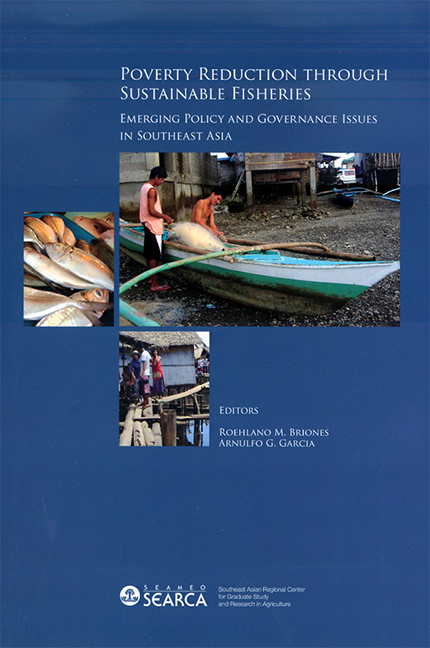 Poverty Reduction through Sustainable Fisheries
Poverty Reduction through Sustainable Fisheries Book contents
- Frontmatter
- Contents
- Figures
- Tables
- Foreword
- Acknowledgments
- 1 Introduction and Synthesis
- 2 Fish and the Poor
- 3 Fish and the Poor: The Case of Cambodia
- 4 Changing Demand and Supply Structure of Fish in Asia: Past Trends and Future Projections
- 5 Regional Economic Integration of the Fisheries Sector in ASEAN Countries
- 6 Technology Policies for Capture Fisheries and Aquaculture in Southeast Asia
- 7 The Status, Current Trends and Future Directions for Production and Technology of Fisheries in Southeast Asia
- 8 The Seafood Supply Chain and Poverty Reduction
- 9 Strategy for the Empowerment of Aquaculture Fish Farmers in Indonesia
- 10 Status of Coastal and Marine Resources: Implications for Fisheries Management and Poverty in Southeast Asia
- 11 Property Rights and Institutional Arrangements in Southeast Asian Fisheries
- 12 Regional Cooperation in Aquatic Resource Management for Southeast Asia
4 - Changing Demand and Supply Structure of Fish in Asia: Past Trends and Future Projections
Published online by Cambridge University Press: 21 October 2015
- Frontmatter
- Contents
- Figures
- Tables
- Foreword
- Acknowledgments
- 1 Introduction and Synthesis
- 2 Fish and the Poor
- 3 Fish and the Poor: The Case of Cambodia
- 4 Changing Demand and Supply Structure of Fish in Asia: Past Trends and Future Projections
- 5 Regional Economic Integration of the Fisheries Sector in ASEAN Countries
- 6 Technology Policies for Capture Fisheries and Aquaculture in Southeast Asia
- 7 The Status, Current Trends and Future Directions for Production and Technology of Fisheries in Southeast Asia
- 8 The Seafood Supply Chain and Poverty Reduction
- 9 Strategy for the Empowerment of Aquaculture Fish Farmers in Indonesia
- 10 Status of Coastal and Marine Resources: Implications for Fisheries Management and Poverty in Southeast Asia
- 11 Property Rights and Institutional Arrangements in Southeast Asian Fisheries
- 12 Regional Cooperation in Aquatic Resource Management for Southeast Asia
Summary
ABSTRACT
In the last three decades the structure of demand and supply of fish has changed dramatically. Global demand has risen rapidly, matched by production growth, mainly from aquaculture, along with increased global trade. Higher demand is driven by rising incomes and populations. Increases in fish supply were made possible by technical change. Global trade is concentrated on exports of high value fish from developing Asia to developed countries. Projections of future demand and supply in Asia indicate the following: a) demand for fish will keep rising but the species mix may change; b) aquaculture can provide significant expansion in production; c) supply growth will slow down, leading to an increase in fish prices; and d) with few exceptions, per capita consumption of fish would continue to rise. Scenario analysis shows that productivity improvement for freshwater fish, which tends to be low value, leads to increases in its consumption, contributing to food security of the poor.
INTRODUCTION
The supply of and demand for fish have changed dramatically during the last three decades. Global demand for fish has risen rapidly with rising populations and increasing per capita income. The rise in demand has been met by a rapid growth in production and increased global trade. The fastest growing component is aquaculture, whereas capture fisheries have remained generally stagnant.
Asia is the leading contributor to this expansion accounting for over 63 per cent of total fish production, and as much as 90 per cent of all aquaculture output (FAO 2006). During the 1950s and 1960s, capture fish production in Asia increased by an average of 6 per cent per annum, but this declined to 3 per cent during the 1970s and 1990s (FAO 2006). In contrast to the declining growth in capture fisheries, aquaculture in the region has been growing rapidly, by about 10 per cent per year during the 1950s and 1960s, about 9 per cent during the 1970s and 1980s, and over 11 per cent since 1990 (FAO 2006). Aquaculture production in Asia has increased from 5.1 per cent of total fish production in 1950, to 46 per cent in 2003.
- Type
- Chapter
- Information
- Poverty Reduction through Sustainable FisheriesEmerging Policy and Governance Issues in Southeast Asia, pp. 51 - 74Publisher: ISEAS–Yusof Ishak InstitutePrint publication year: 2008


